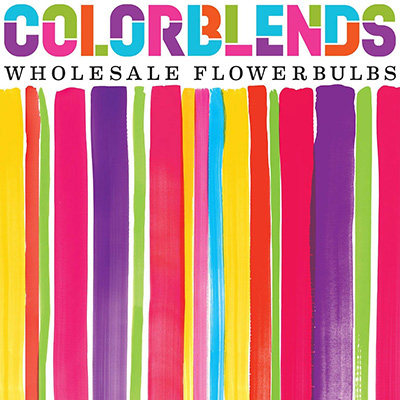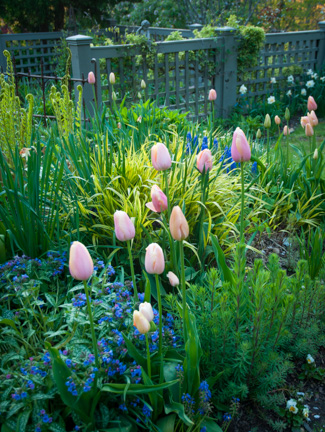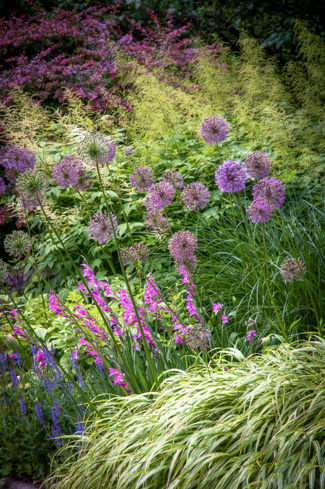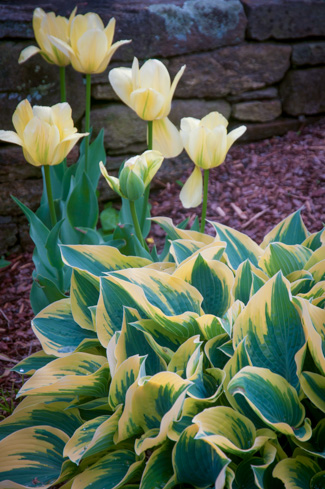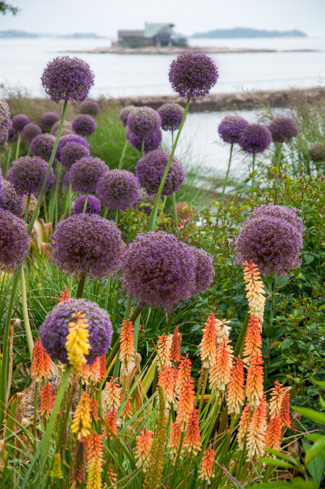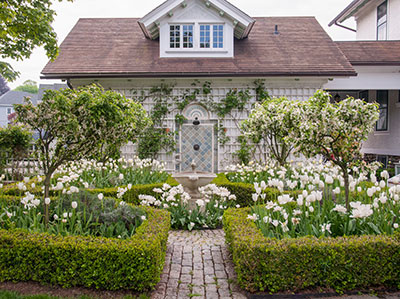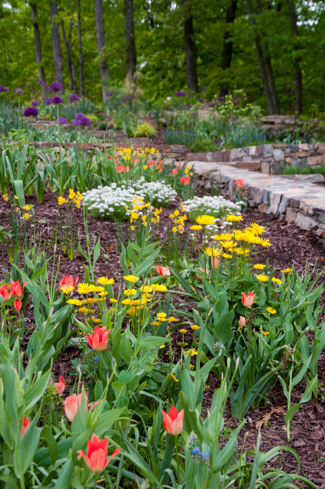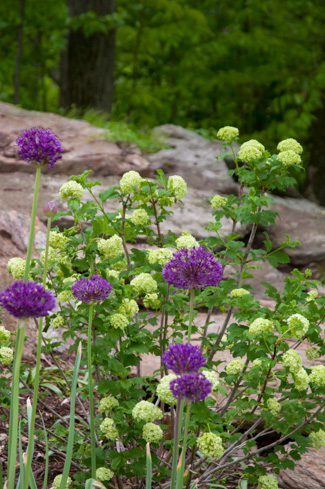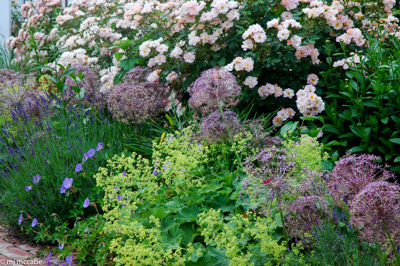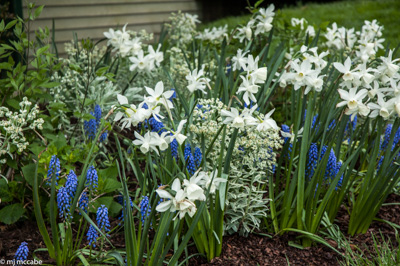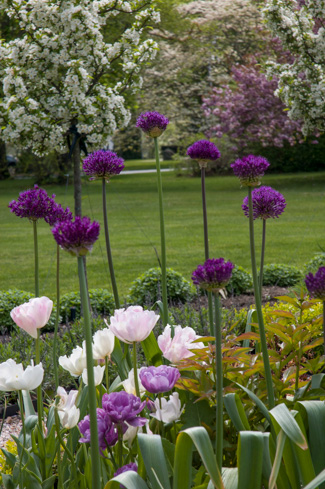Janie McCabe
Design Notes
Designing for Deer Resistance
Combo: In spring: hellebores, dwarf daffodils, Pulmonaria, Epimedium (barrenwort or bishop’s hat), Viola ‘Lemon Sorbet’ and Tulipa ‘Apricot Impression’ (Darwin hybrid tulip, apricot with pink, blooms midseason). Late spring into summer: Hakonechloa (Japanese forest grass) with ferns and Linum (flax). Joined in late summer/fall by Kirengeshoma palmata (yellow wax bells) plus naturalized Colchicum.
Location: Janie’s garden in Northford, Connecticut, USDA Zone 6b
Notes: An old apple tree is a prized feature in this area of my garden. The surrounding perennial bed changes throughout the year. With two exceptions, every plant in this setting is deer resistant. The exceptions are tulips and violas. Happily, though both are vulnerable to deer, typically neither is bothered here thanks to their unpalatable neighbors. In spring, there’s plenty of sunlight so the daffodils come back year after year. Every year, I plant fresh tulips. For the fun of it, I change the color scheme each year, planting all of one kind. Perennial spring color is provided by naturalized miniature daffodils, purple-flowered Epimedium, purple-flowered Helleborus and brilliant-blue Pulmonaria. I also add yellow violas in spring, which reseed nicely so they rebloom in fall. By late spring, I pull the tulips.
In summer and fall the bed is partially shaded and stays fairly moist, though not overly damp. Lush foliage dominates, with color unfolding in waves. First the underplanting of grassy Hakonechloa fills in, then is joined by the ferns, the foliage of Linum and Kirengeshoma pallata. In late spring, a long-lasting wave of blue kicks in, as the bee-loving Linum flowers come into bloom. By August, the waxy yellow flowers of Kirengeshoma have taken over, lasting into fall. By October, a pink carpet of naturalized Colchicum is the big show, now rejoined by the yellow violas.
Flawless Transitional Combo
Combo: Allium ‘Purple Sensation’ (blooms late spring/early summer); Gladiolus communis ssp byzantinus (magenta flowers, blooms late spring/early summer);
Hakonechloa macra ‘Aureola’ (Japanese forest grass, mounded, cascading golden grass); Aruncus ‘Horatio’ (goat’s beard, tiny white flowers, blooms early to midsummer); Salvia x sylvestris ‘Blue Hill’; Cotinus coggygria ‘Royal Purple’ (deep-magenta foliage in spring, red in fall).
Location: Conservatory Garden in Central Park, New York, New York, USDA Zone 7b
Notes: I spotted this gorgeous plant partnership at the Conservatory Garden in Manhattan’s Central Park. I love how it maximizes the transition from late spring into summer, with a layering of texture and color that feels flawless to me. Note how the reddish-purple Allium ‘Purple Sensation’ and Gladiolus byzantinus are framed by the glowing Hakonechloa and the fresh green foliage and tiny, creamy-white flowers of the Aruncus, while the brilliant-blue Salvia in the foreground adds the right dollop of punctuation. To the rear, the smoke tree’s dark foliage creates a backdrop that sets off the whole scene.
Impressive Color Echoing
Combo: Tulipa ‘Formosa’ (viridiflora tulip, soft yellow with spring-green blush, blooms late) with Hosta ‘Ivory Coast’ (medium large, the yellow margins turn creamy in summer).
Location: Fairfield, Connecticut, USDA Zone 7a
Notes: Here’s another found treasure, this time at Oliver’s Nursery in Fairfield, Connecticut. This is an impressive plant combination that shows the power of color echoing at its best. There’s unusual balance in this pairing, where the same shades of “tulip green” and soft yellow link the tulip and hosta, while their respective color configurations are nearly opposite. To this composition, I envision adding blue Brunnera and yellow, daisy-like Doronicum to enhance and extend the bloom.
Allium, Kniphofia and Grasses
Combo: Fall-planted bulb, purple Allium ‘Ambassador’ with perennials, including: orange-and-yellow Kniphofia (red hot poker) and grasses Calamagrostis ‘Karl Foerster’ and Pennisetum ‘Hameln’.
Location: Branford, Connecticut, USDA Zone 7a
Notes: The color contrast is wonderful in hazy coastal light and jaw-dropping when backlit by the sun, late afternoon till sunset. The allium and red hot pokers are flanked by perennial grasses, which effectively hide the yellowing allium foliage during its dieback phase. The entire mix provides for a long season of interest with plants that silhouette beautifully against the water. Equally important: these plants are tough nuts that take coastal conditions in stride.
White-on-White Color Scheme
Combo: Boxwood hedge of Buxus ‘Tide Hill’ and white-flowering, dwarf crabapples. In spring: Narcisuss ‘Thalia’ and mixed white tulips, including: single late ‘Maureen’, double late ‘Mount Tacoma’, lily-flowered ‘White Triumphator’ and fringed ‘Swan Wings’. In summer: Allium ‘Mount Everest’, followed by Scaevola and Euphorbia ‘White Frost’. In fall: Anemone japonica ‘Honorine Jobert’.
Location: Milford, Connecticut, USDA Zone 7a
Notes: This was a project for a longtime client on which I cooperated with David Duncan of Needham Duncan Architecture of Old Lyme, Connecticut. My assignment was to create a new garden adjacent to the garage addition David was designing for the client’s 1909-built home. The resulting structure and garden meld beautifully with the relaxed elegance of the original property.
Boxwood hedging and dwarf crabapple trees anchor the garden beds. In this setting, a white-on-white color scheme is appealing spring through fall. The bloom season opens with diminutive, multi-flowering N. ‘Thalia’. Next up are a mix of white tulips that bloom mid-late to late spring. Right after bloom, we pull the tulips. By then, Allium ‘Mount Everest’ is taking over. In summer the white-on-white scheme continues with a ground-cover-planting of Scaevola and Euphorbia. In fall, the naturalized Japanese anemone comes up.
Each fall, we plant fresh tulip bulbs and additional alliums. Typically we plant here by Thanksgiving.
Hillside Mix of Bulbs and Perennials
Combo: Red-orange species tulips, white Narcissus ‘W.P. Milner’ and yellow Narcissus ‘Baby Boomer’, purple Allium ‘Purple Sensation’, yellow Doronicum oriental (oriental leopard’s bane), white Iberis ‘Kingwood Compact’ (candytuft), blue Campanula poscharskyana (Serbian bellflower) and green Hakonechloa (Hakone grass).
Location: Middletown, Connecticut, USDA Zone 6b
Notes: I like to add small surprises for my clients. When I tuck in spring-blooming bulbs, people are bowled over by the unexpected color. A patch of brilliant-blue Iris reticulata will hook anyone. People fall in love with bulbs. For this sunny site, the surprise was species tulips. These have now naturalized here. No animal problems to date.
For me, pest resistance is always a factor. Eighty percent of my clients in coastal Connecticut have trouble with deer, voles, moles and rabbits. For spring color, pest-proof daffodils are always a top choice. Alliums are very reliable too.
Tulips are tricky. But, what’s spring without tulips? Even small doses make such a difference. I find there’s usually a way to work in tulips—you just need to outfox the foragers. The bulbs are not expensive, so it’s worth experimenting with surprise clusters here and there, to push the envelope, to learn where you’ll have success. Never assume tulips won’t work.
For certain sites, I treat tulip bulbs to keep diggers away. I soak the bulbs in my own mix: 1/4 cup liquid Lysol to 3 gallons water. A quick soak is plenty. Spread the bulbs out to dry before planting.
Allium and Snowball Viburnum
Combo: Allium ‘Purple Sensation’ with Viburnum opalus roseum (old-fashioned snowball viburnum).
Location: Guilford, Connecticut, USDA Zone 6b
Notes: These are both heirloom varieties suited to a spare location. Also, both are reasonably priced thus affordable in mass plantings. The viburnum will fill out fairly quickly. The allium will rebloom for 3 or 4 years. I’ll add more allium bulbs every few years.
Alliums, Shrub Roses and Perennials
Combo: Allium christophii, pink shrub rose ‘Mystic Marvel’, Lavandula angustifolia ‘Hidcote Blue’ (English lavender), Geranium ‘Rozanne’, Alchemilla mollis (lady’s mantle) and Leucanthemum x superbum (Shasta daisy).
Location: Madison, Connecticut, USDA Zone 6b
Notes: This bed, positioned just steps from the front door of a beautiful waterside home, is designed for long-lasting seasonal color and easy maintenance. In summer, the perennials and repeat-blooming shrub roses carry the ball. An unexpected layer of interest is provided by the large, airy umbels of the Allium christophii. In spring, tulips are the star attraction—each year a different color. I pick tulip varieties or a blend in that color to provide sequential bloom, April till mid-May. After bloom, we pull the tulips here. In fall, we choose a new color and replant. This particular year, we chose orange.
Narcissus, Muscari and Euphorbia
Combo: White Narcissus ‘Thalia’, cobalt-blue Muscari armeniacum and variegated Euphorbia characias ‘Glacier Blue’.
Location: Madison, Connecticut, USDA Zone 6b
Notes: Here a crisp blue and white color scheme brightens a west-facing spot with plenty of sunshine in spring. The daffodil and Muscari bulbs naturalize here and come back to bloom each spring. The variegated Euphorbia is less reliable, being rated for USDA Zones 7-10. So I’m prepared to replace it each April, if needed.
By late spring, the daffodils and Muscari decline and the Euphorbia, hostas and ferns fill out, masking the fading bulb foliage. During this stretch, the bulb plants get enough sun to recharge their bulbs with energy for next year’s bloom.
Alliums and Double Tulips
Combo: Allium ‘Purple Sensation’ with double late Tulips ‘Angelique’, ‘Mount Tacoma’ and ‘Blue Spectacle’. Also: boxwood, phlox, delphiniums and peonies (including Paeonia ‘Sarah Bernhardt’ and P. ‘Festiva Maxima’).
Location: Old Saybrook, Connecticut, USDA Zone 6b
Notes: The alliums here are dramatic and reliable. In this setting, I like Allium ‘Purple Sensation’, which are inexpensive, so you can plant lots and play with them. ‘Purple Sensation’ is a particularly rich purple color and gives you the vertical interest and vitality of alliums, but with an umbel that’s more reserved in scale, just 4-inches across. By the time the allium foliage here begins to look shabby, the perennials are big enough to hide it.
Typically, the alliums come back to rebloom for three or more years. Often, they’ll multiply, too. If I plant 100 bulbs, it’s not unusual to end up with 130. Every few years, l plant more.
Nearby is a compact hedge of strongly-scented Calamintha nepeta alba (white catmint) that serves as a buffer to discourage rabbits.
